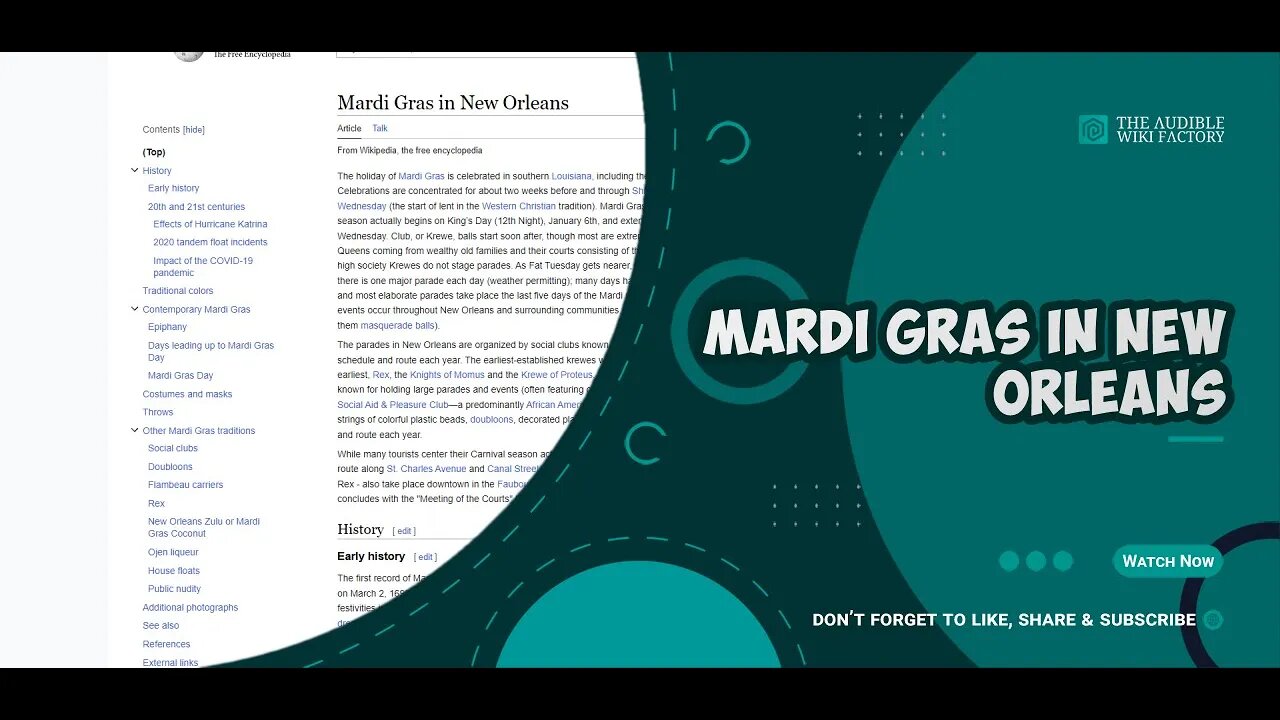Premium Only Content

The holiday of Mardi Gras is celebrated in southern Louisiana, including the city of New
The holiday of Mardi Gras is celebrated in southern Louisiana, including the city of New Orleans. Celebrations are concentrated for about two weeks before and through Shrove Tuesday, the day before Ash Wednesday (the start of lent in the Western Christian tradition). Mardi Gras is French for Fat Tuesday, but the season actually begins on King’s Day (12th Night), January 6th, and extends until midnight before Ash Wednesday. Club, or Krewe, balls start soon after, though most are extremely private, with their Kings and Queens coming from wealthy old families and their courts consisting of the season’s debutantes. Most of the high society Krewes do not stage parades. As Fat Tuesday gets nearer, the parades start in earnest. Usually there is one major parade each day (weather permitting); many days have several large parades. The largest and most elaborate parades take place the last five days of the Mardi Gras season. In the final week, many events occur throughout New Orleans and surrounding communities, including parades and balls (some of them masquerade balls).
The parades in New Orleans are organized by social clubs known as krewes; most follow the same parade schedule and route each year. The earliest-established krewes were the Mistick Krewe of Comus, the earliest, Rex, the Knights of Momus and the Krewe of Proteus. Several modern "super krewes" are well known for holding large parades and events (often featuring celebrity guests), such as the Krewe of Endymion, the Krewe of Bacchus, as well as the Zulu Social Aid and Pleasure Club—a predominantly African American krewe. Float riders traditionally toss throws into the crowds. The most common throws are strings of colorful plastic beads, doubloons, decorated plastic "throw cups", and small inexpensive toys. Major krewes follow the same parade schedule and route each year.
While many tourists center their Carnival season activities on Bourbon Street, major parades originate in the Uptown and Mid-City districts and follow a route along St. Charles Avenue and Canal Street, on the upriver side of the French Quarter. Walking parades - most notably the Krewe du Vieux and 'tit Rex - also take place downtown in the Faubourg Marigny and French Quarter in the weekends preceding Mardi Gras Day. Mardi Gras Day traditionally concludes with the "Meeting of the Courts" between Rex and Comus.
HISTORY
EARLY HISTORY
The first record of Mardi Gras being celebrated in Louisiana was at the mouth of the Mississippi River in what is now lower Plaquemines Parish, Louisiana, on March 2, 1699. Iberville, Bienville, and their men celebrated it as part of an observance of Catholic practice. The date of the first celebration of the festivities in New Orleans is unknown. A 1730 account by Marc-Antoine Caillot celebrating with music and dance, masking and costuming (including cross-dressing). An account from 1743 that the custom of Carnival balls was already established. Processions and wearing of masks in the streets on Mardi Gras took place. They were sometimes prohibited by law, and were quickly renewed whenever such restrictions were lifted or enforcement waned.
In 1833, Bernard Xavier de Marigny de Mandeville, a rich plantation owner of French descent raised money to fund an official Mardi Gras celebration. James R. Creecy in his book Scenes in the South, and Other Miscellaneous Pieces describes New Orleans Mardi Gras in 1835:
Shrove Tuesday is a day to be remembered by strangers in New Orleans, for that is the day for fun, frolic, and comic masquerading. All of the mischief of the city is alive and wide awake in active operation. Men and boys, women and girls, bond and free, white and black, yellow and brown, exert themselves to invent and appear in grotesque, quizzical, diabolic, horrible,...
LINK TO ARTICLE: http://en.wikipedia.org/wiki/Mardi_Gras_in_New_Orleans
TAGS: Mardi Gras in New Orleans, Carnivals in the United States, Tourist attractions in New Orleans, Festivals in New Orleans, Economy of New Orleans, Mardi Gras in New Orleans
#GeneralKnowledge #AudibleWikiFactory #Audible #Wikipedia #MardiGrasinNewOrleans
-
 13:12
13:12
The Audible Wiki Factory
1 year agoThe Carnival of Venice is an annual festival held in Venice, Italy. The carnival ends on Shrove
512 -
 3:17:18
3:17:18
Price of Reason
12 hours agoTrump Cabinet Nominees RFK & Tulsi CONFIRMED! Captain America 4 EARLY Review! Avowed a DISASTER?
59K7 -
 2:41:39
2:41:39
TimcastIRL
8 hours agoDOGE IS IN THE IRS, Democrats Launch 14 Lawsuits To STOP Trump & Elon w/Nate Cain | Timcast IRL
172K104 -
 2:04:28
2:04:28
Kim Iversen
11 hours agoTHE SHAKEUP BEGINS! What Will RFK Jr Do In His First Few Days As HHS Secretary?
79.6K92 -
 1:13:58
1:13:58
The Charlie Kirk Show
8 hours agoTHOUGHTCRIME Ep. 73 — Tattoo Vibe Shift? RFK's Day 1 Agenda? Subway Speakerphone Ban?
148K50 -
 26:10
26:10
Mrgunsngear
11 hours ago $4.85 earnedRomanian RPK Review: The Warsaw Pact's M249 SAW
41.3K6 -
 1:52:40
1:52:40
StaleSavage
9 hours agoCrows Nest Gaming Community
103K2 -
 51:17
51:17
Man in America
13 hours ago🚨 CCP’s SECRET WAR on America—Military Insider Sounds the ALARM! w/ Matthew Newgent
62K32 -
 6:53:51
6:53:51
SpartakusLIVE
10 hours ago#1 HACKER gets UNBANNED || The MASSES Rejoice, The Accusers TRIGGERED
83.9K1 -
 54:33
54:33
Flyover Conservatives
1 day agoThe #1 Mistake Singles Make That Keeps Them Alone Forever - Jackie Dorman | FOC Show
67.1K4